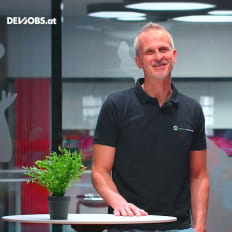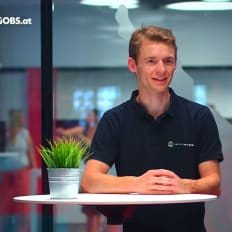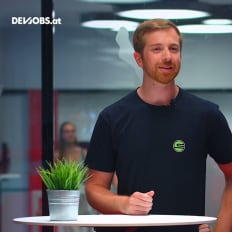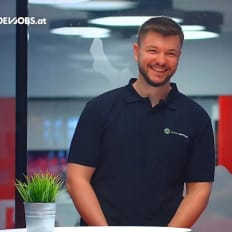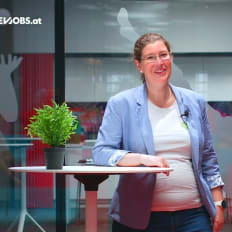
solvistas GmbH
Fabian Weißenböck, Software Developer bei solvistas
Description
Fabian Weißenböck von solvistas redet in seinem Interview über seine Anfänge mit dem Programmieren, was er aktuell in seiner Arbeit macht und was seiner Meinung nach wichtig für Beginner ist.
By playing the video, you agree to data transfer to YouTube and acknowledge the privacy policy.
Video Summary
In "Fabian Weißenböck, Software Developer bei solvistas," Speaker Fabian Weißenböck outlines his path from an HTL with mandatory internships to full-time work after graduation, then an informatics degree pursued alongside part-time roles through to his master’s. At solvistas he values the variety beyond pure coding, often supporting the full project lifecycle from requirements gathering and customer conversations through implementation to completion. His advice: bring determination, invest time with online courses, start with HTML then JavaScript, and follow your interests—whether games or web—to become job-ready.
From HTL internships to end‑to‑end delivery: What we learned from “Fabian Weißenböck, Software Developer bei solvistas” (solvistas GmbH) about getting started, studying, and real project work
A practical path: internships, full-time work, and part-time study
The session with “Fabian Weißenböck, Software Developer bei solvistas” (solvistas GmbH) offered a grounded blueprint for becoming a developer: start early, stay with it, and keep pairing learning with real work. The outline is refreshingly straightforward. He began in an Austrian HTL focused on informatics, where students are required to complete eight weeks of internship. That requirement becomes a door into real companies and projects. In Fabian’s words, you get into “die ganzen Firmen” through the HTL pathway.
That experience matters because by the time you finish the HTL and graduate (Matura), you’re not starting from scratch. Fabian puts it plainly: after HTL you can already begin working as a developer and “brauchst kein Studium dafür” — you don’t strictly need a university degree to get your first job.
His own path balances both. Right after HTL, he started working full-time. About half a year later, he began his computer science degree. He worked part-time throughout his Bachelor’s, continued part-time into the end of his Master’s, and plans to switch to full-time again afterward. It’s a steady, practical rhythm: let real-world experience inform your studies, and let academic learning sharpen your work.
Not just coding: What end‑to‑end involvement at solvistas GmbH looks like
Fabian highlights something many engineers crave: a role that goes beyond writing code. At solvistas GmbH, he doesn’t find a narrow “I only program” lane, but a mix that includes organizational responsibilities alongside development. The balance varies with each project and the team’s role distribution, but the pattern is consistent.
He often joins from the very beginning of a project — requirements gathering, talking directly to the customer, offering input where it helps, and then delivering the implementation.
“You accompany projects from the start … implement with the customer and go through the entire project phase from beginning to end.”
For him, that variety is a big deal. It means seeing the whole arc from the first conversation to the finished solution. It’s not just about features, but about context, communication, and the discipline of bringing something across the line.
What you really need: Will, time, and persistence
Fabian is disarmingly direct about prerequisites. The main thing you need is the will to do it. You have to sit with it for a while “bis du wirklich jobreif bist” — until you’re truly ready for the job. Everything else, from course catalogs to documentation, is accessible. “Es gibt Kurse von bis,” he notes — there are online courses of all kinds.
But the decisive factor is persistence, especially in areas that genuinely interest you. “Wichtig ist, dass du dranbleibst … schau dir die Sachen an, die dir taugen.” If you love games, start with games. If you’re drawn to web development, start with websites. Fabian’s suggested entry point is HTML, which gives you immediate, visible results. From there, move on to JavaScript when you’re ready. Once it clicks, momentum builds: “Ab dem Zeitpunkt läuft es dann wirklich.”
Milestones and takeaways from Fabian’s journey
We heard a set of milestones that align into a practical learning and career loop:
- HTL with compulsory internship: Use early industry exposure to see real teamwork and projects.
- Job-ready after graduation: It’s realistic to start working as a developer right after HTL.
- Work–study combination: Let theory and practice reinforce each other — study part-time while applying concepts at work.
- End-to-end project work: Get involved from requirements through delivery, not just in isolated coding tasks.
- Interest-led learning: Start where motivation is strongest (HTML for web, games if that’s your passion) and then layer on JavaScript.
- Persistence to become “job-ready”: You need time in the chair and continuity to reach professional level.
Together, these points add up to more than a checklist — they form a mindset for building a developer career step by step.
Why the HTL route matters
Fabian’s remarks about internships underline an important point: eight weeks inside a company aren’t just a line on a resume. That time means exposure to real development rhythms — teams, tickets, reviews, the give-and-take of changing requirements. It’s part of why he can say that a degree isn’t mandatory to start working after HTL. The internship is where theory starts to meet reality.
This isn’t a dismissal of university; it’s a reframing. A degree can deepen your understanding and give structure. But the entry ticket to real work is not the diploma — it’s your willingness to do the work and stay at it until you’re “jobreif.”
Pairing work and study: Practice as the proving ground
Starting full-time and then adding university half a year later flips the order many people expect. For Fabian, it works because every lecture topic meets lived experience. Requirements gathering isn’t abstract when you’ve sat with a customer and teased out what they actually need. Implementation isn’t just an algorithm; it’s code you know will be tested, integrated, and deployed.
Part-time work during a Bachelor’s and into a Master’s forces prioritization. It reshapes learning away from hoarding concepts and toward focusing on what is necessary to make projects succeed: understanding the domain, clarifying requirements, anticipating risks, and writing code that can be changed and maintained.
Beyond code: What end‑to‑end really teaches
When Fabian says he sees projects through “from the very start to completion,” he’s pointing to a richer developer role:
- Requirements are about translating user language into implementable clarity.
- Talking to the customer is about setting expectations and offering practical options.
- “Giving input” elevates you from a task taker to a partner in shaping the solution.
- Implementing is building what was agreed — robustly, with the constraints in mind.
That loop is powerful because it creates feedback. Knowing the why improves the what. Building the how teaches you the consequences of design decisions. Seeing acceptance and closure tests your quality against reality.
Motivation first: HTML as a door, JavaScript for behavior
Fabian’s advice to begin with HTML isn’t random. It’s tangible and fast: write, save, refresh — and you can see it. That short feedback loop fuels learning. JavaScript naturally follows, adding behavior and control over how things respond. If you’re into games, the same loop applies: start small, see results, iterate quickly.
When he says “Ab dem Zeitpunkt läuft es dann wirklich,” he’s describing that inflection point when practice turns into momentum, projects start to come together, and you no longer feel like everything is brand new.
Becoming “job-ready”: The craft of consistency
The word that echoes through Fabian’s story is “dranbleiben” — sticking with it. It’s deceptively simple and notoriously hard. It means time blocks, finishing small projects, resisting the urge to hop to a new tutorial every day.
He doesn’t overemphasize tools or secrets. The core is willingness. From there, the sequence he sketches is pragmatic: HTML first, then JavaScript; early involvement in requirements, then implementation; and gradually owning more of the project lifecycle.
Turning Fabian’s guidance into actionable steps
From a DevJobs.at editorial perspective, here’s a practical way to operationalize Fabian’s points without overcomplicating:
- Plan internships intentionally: Use every week to observe and participate in real workflows — tickets, reviews, feedback, delivery.
- Apply right after school if you’re ready: If coding clicks for you, start working — even before or without a degree. Build a small portfolio, even if it’s just HTML/JavaScript demos.
- Treat university as an amplifier: Begin when it fits your life. Map lectures to problems you’ve seen at work; let practice guide what you study deeper.
- Aim for end‑to‑end exposure: Ask to sit in on requirements workshops, customer calls, and acceptance sessions. Avoid the “code-only silo.”
- Let interest lead: Games? Build games. Websites? Build websites. Motivation keeps you going long enough to become good.
- Ritualize persistence: Fixed times, small scopes, visible outcomes. Finish what you start, even if it’s not perfect.
Customer conversations as a learning engine
One detail Fabian highlights is interacting directly with customers and offering input. That shift from pure implementation to collaborative shaping increases your sense of responsibility. It teaches you to estimate more realistically and to see that every choice has trade-offs. Early exposure to that kind of dialogue extends your influence — and your learning — beyond the code editor.
Roles depend on the project: Flexibility over fixed templates
Fabian emphasizes that responsibilities “depend on the project” and the team’s role distribution. That matters because it tempers simplistic narratives about developer jobs. Sometimes you’ll lean more into implementation; other times you’ll handle organizational threads. The key is to treat both as part of the craft and to explore where you bring the most value in a given team setup.
A learning model: From visible output to structured thinking
The path Fabian outlines — from visible HTML to more structured JavaScript — doubles as a learning model:
- Start with something you can see: fast feedback accelerates improvement.
- Add behavior: once the surface exists, logic brings it to life.
- Add context: requirements and customer conversations supply the “why.”
Over time, these layers combine: surface, behavior, context. Thinking that way helps you build solutions rather than isolated features.
Realistic expectations: Less hype, more craft
What stands out in Fabian’s account is its grounded tone. There are no shortcuts promised. Instead, he points to levers that anyone can pull: your will, your time, your persistence. Early industry exposure — internships and part-time work — raises the slope of your learning curve.
As a result, the path he sketches works for different starting points: HTL graduates, university students, and career changers alike. The formula remains steady:
- get into real projects early,
- stay with it long enough to become “job-ready,”
- understand the entire lifecycle,
- start from what truly interests you,
- and let practice and theory reinforce each other.
Closing: A profession becomes real when you practice it
In “Fabian Weißenböck, Software Developer bei solvistas” (solvistas GmbH), we heard a developer who treats software as a craft shaped by doing. HTL and internships create the first opening. Working full-time before and alongside university ties academic learning to reality. Seeing projects through from start to finish teaches you to connect requirements, communication, and implementation.
And the learning path? It begins concretely. “HTML is a good start.” Choose what excites you — games or websites — and stick with it. When the fundamentals and your motivation align, momentum builds.
“Wichtig ist, dass du dranbleibst … Ab dem Zeitpunkt läuft es dann wirklich.”
That’s the core message we’re taking away: software development isn’t secret knowledge. It’s a discipline that grows with your commitment — through will, time, and the curiosity to be part of entire projects, not just isolated tasks.
More Dev Stories
solvistas GmbH Jochen Falkner, Senior Data Scientist bei solvistas
Jochen Falkner von solvistas erzählt im Interview von seinem Weg in die IT, den Aufgaben als Senior Data Scientist und welche Ratschläge er Neueinsteigern mitgeben würde.
Watch nowsolvistas GmbH Theo Crazzolara, Data Engineer bei solvistas
Theo Crazzolara von solvistas gibt im Interview Einblicke in seine Anfänge mit dem Programmieren, was er täglich im Data Engineering zu tun hat und was seiner Meinung wichtig für Beginner ist.
Watch nowsolvistas GmbH Markus Hiesmair, Software Engineer bei solvistas
Markus Hiesmair von solvistas erzählt im Interview über seinen Werdegang als Software Engineer – angefangen von der Schulzeit bis hin zur aktuellen Arbeit – und gibt Tipps für Neueinsteiger.
Watch nowsolvistas GmbH Michaela Raab, Data Scientist bei solvistas
Michaela Raab von solvistas gibt im Interview Einblicke in ihren Background, sowie ihren aktuellen Job als Data Scientist und gibt Tipps für Neueinsteiger.
Watch nowsolvistas GmbH Mateo Adzaga, UX Designer bei solvistas
Mateo Adzaga von solvistas redet im Interview über seine Tätigkeit als UX Designer, wie er damit begonnen hat und was er selbst gerne als Anfänger gewusst hätte.
Watch nowsolvistas GmbH Sophie Brückl, Product Owner bei solvistas
Sophie Brückl von solvistas teilt im Interview ihre Erfahrungen beim Wechsel vom Software Development hin zur aktuellen Arbeit als Product Owner und welche Tipps sie jenen gibt, die ähnliche Schritte planen.
Watch now

